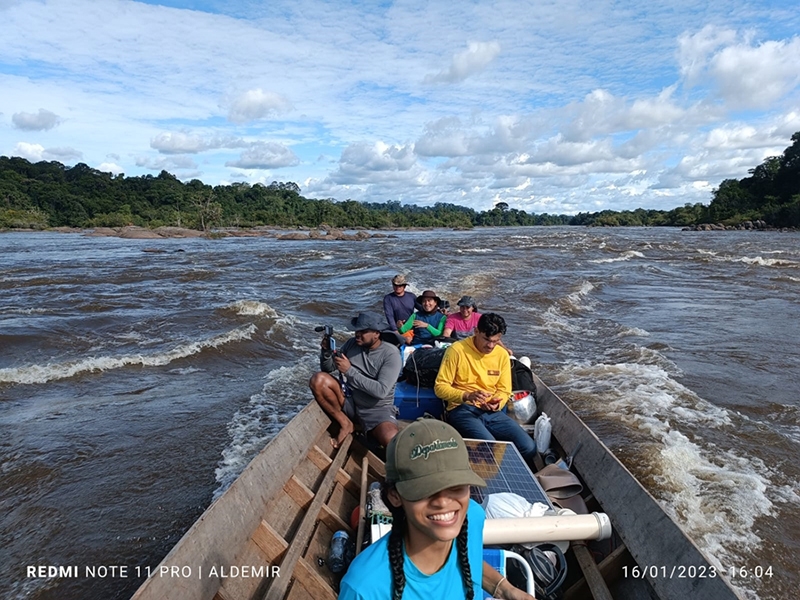New Study Examines Historical Drought and Flooding on the Amazon River

Colleagues from Laranjal do Jari, a municipality on the Jari River, which is a tributary of the Amazon.
Extreme floods and severe droughts on the Amazon River have occurred more frequently in the last 40 years. Eight of the 12 most extreme floods in the 121-year streamflow record at Manaus, located on the Negro River, a tributary of the Amazon River, have occurred in just the last 14 years.
Natural climate variations, deforestation and anthropogenic climate change are all likely contributors to the recent Amazon River level extremes. Despite the rapid increase in severe flooding, a new paper by researchers from the U of A indicates recent floods and droughts in the Amazon River Basin may have not yet exceeded the range of natural hydroclimatic variability.
The American Meteorological Society published these recent findings by Daniela Granato-Souza, a post-doctoral student in geosciences, and David Stahle, a Distinguished Professor of geosciences, in a new paper titled, “Drought and flood extremes on the Amazon River and in northeast Brazil, 1790-1900.”
Using tree-ring analysis to reconstruct rainfall totals in the eastern Amazon, along with historical documentary accounts of extreme flooding in Manaus and Santarem, Granato-Souza and Stahle found evidence indicating that Amazon River floods in 1859 and 1892 may have equaled or exceeded recent flooding.
The biggest difference between then and now, though, is the size of the population now living in the flood plain.
“There are millions of people residing in Manaus, the most populous city in northern Brazil, so there is a socioeconomic concern in these regions,” noted Granato-Souza. “Usually, poorer people are seen living in risk areas, and with each flood they suffer the consequences of loss and illness. There is a ‘normal’ for the maximum level that the river reaches, but the most extreme floods exceed this threshold, and studies have shown that this is intensifying.”
Granato-Souza added that while they found the recent extreme floods weren’t unprecedented, examining the scale of past flooding provides a framework for imagining and anticipating the environmental and socioeconomic consequences of future floods.
And they would likely be devastating for a population living in high-risk areas.
The tree-ring collections used in this research came from the Rio Paru, a tributary of the Amazon near the recent discovery site of the tallest trees in the Brazilian Amazon. Descriptions of the giant trees in the remote and unspoiled Rio Paru drainage has captivated public interest in Brazil and abroad. Stahle and Granato-Souza are working with environmental scientists in Brazil, including Diego da Silva with the Federal Institute of Amapa, Robson Borges with Amapa State University and Eric Gorgens with the Federal University of the Jequitinhonha and Mucuri Valleys, to help answer often-asked questions concerning the age, growth rate, disturbance history and the climate sensitivity of these tropical hardwoods.
About the University of Arkansas: As Arkansas' flagship institution, the U of A provides an internationally competitive education in more than 200 academic programs. Founded in 1871, the U of A contributes more than $2.2 billion to Arkansas’ economy through the teaching of new knowledge and skills, entrepreneurship and job development, discovery through research and creative activity while also providing training for professional disciplines. The Carnegie Foundation classifies the U of A among the few U.S. colleges and universities with the highest level of research activity. U.S. News & World Report ranks the U of A among the top public universities in the nation. See how the U of A works to build a better world at Arkansas Research and Economic Development News.
Topics
Contacts
David W. Stahle, distinguished professor of geosciences
Fulbright College of Arts and Sciences
479-575-3703,
dstahle@uark.edu
Hardin Young, assistant director of research communications
University Relations
479-575-6850,
hyoung@uark.edu
Headlines
PetSmart CEO J.K. Symancyk to Speak at Walton College Commencement
J.K. Symancyk is an alumnus of the Sam M. Walton College of Business and serves on the Dean’s Executive Advisory Board.
Faulkner Center, Arkansas PBS Partner to Screen Documentary 'Gospel'
The Faulkner Performing Arts Center will host a screening of Gospel, a documentary exploring the origin of Black spirituality through sermon and song, in partnership with Arkansas PBS at 7:30 p.m. Thursday, May 2.
UAPD Officers Mills and Edwards Honored With New Roles
Veterans of the U of A Police Department, Matt Mills has been promoted to assistant chief, and Crandall Edwards has been promoted to administrative captain.
Community Design Center's Greenway Urbanism Project Wins LIV Hospitality Design Award
"Greenway Urbanism" is one of six urban strategies proposed under the Framework Plan for Cherokee Village, a project that received funding through an Our Town grant from the National Endowment for the Arts.
Spring Bike Drive Refurbishes Old Bikes for New Students
All donated bikes will be given to Pedal It Forward, a local nonprofit that will refurbish your bike and return it to the U of A campus to be gifted to a student in need. Hundreds of students have already benefited.




